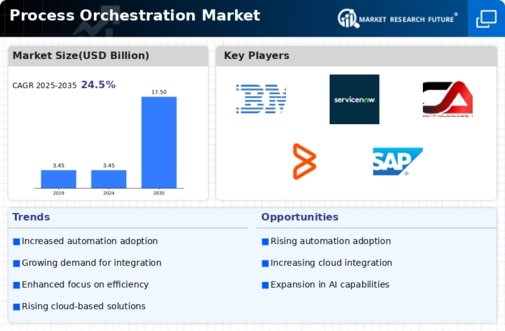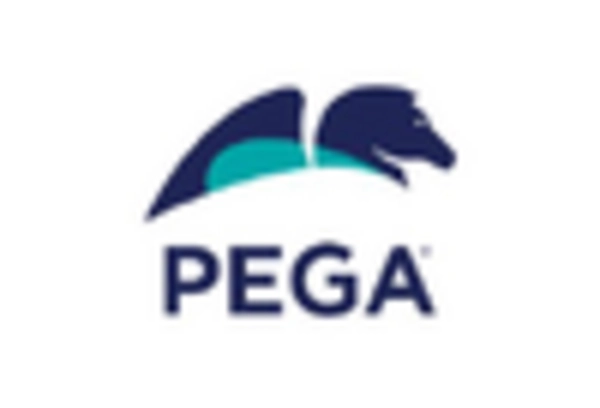-
Executive Summary
-
Scope of the Report
-
Market Definition
- Research Objectives
-
Scope of the Study
-
Assumptions & Limitations
-
Markets Structure
-
Market Research Methodology
-
Research
-
Process
-
Secondary Research
-
Primary
-
Research
-
Forecast Model
-
Market
-
Landscape
-
Porter’s Five Forces Analysis
- Bargaining power of buyers
- Threat of substitutes
- Rivalry
- Bargaining Power of Suppliers
-
Threat of New Entrants
-
Value
-
Chain/Supply Chain of Global Process Orchestration Market
-
Market
-
Overview of Global Process Orchestration Market
-
Introduction
-
Growth Drivers
-
Impact Analysis
-
Market Challenges
-
Market Trends
-
Introduction
-
Growth Trends
-
Impact Analysis
-
Global Process
-
Orchestration Market, By Function
-
Introduction
- Market
- Market Estimates
-
Supply Chain Management and Order Fulfillment
-
Estimates & Forecast, 2020–2027
-
& Forecast, by Region, 2020–2027
-
Human Resource
- Market Estimates & Forecast, 2020–2027
- Market Estimates & Forecast, by Region, 2020–2027
-
Management
-
Finance and Accounting
- Market
- Market Estimates
-
Estimates & Forecast, 2020–2027
-
& Forecast, by Region, 2020–2027
-
Customer
- Market Estimates & Forecast,
- Market Estimates & Forecast, by
-
Service and Support
-
Region, 2020–2027
-
Global Process Orchestration Market,
-
by Component
-
Introduction
-
Solution
- Market Estimates & Forecast, 2020–2027
-
Market Estimates & Forecast, by Region, 2020–2027
-
Services
- Market Estimates
- Market
- Professional
- Managed Services
-
& Forecast, 2020–2027
-
Estimates & Forecast, by Region, 2020–2027
-
Services
-
Estimates & Forecast, 2020–2027
-
Estimates & Forecast, by Region, 2020–2027
-
and Education
-
by Region, 2020–2027
-
Estimates & Forecast, 2020–2027
-
Estimates & Forecast, by Region, 2020–2027
-
Global
-
Process Orchestration Market, by Deployment
-
Introduction
-
Cloud
- Market Estimates &
- Market
-
Forecast, 2020–2027
-
Estimates & Forecast, by Region, 2020–2027
-
On-Premises
- Market Estimates & Forecast, 2020–2027
-
Market Estimates & Forecast, by Region, 2020–2027
-
Global Process Orchestration Market, by Organization Size
-
Introduction
-
SMEs
-
Market Estimates & Forecast, 2020–2027
-
Market Estimates & Forecast, by Region, 2020–2027
-
Large Enterprises
- Market
-
Estimates & Forecast, 2020–2027
-
Market Estimates & Forecast, by Region, 2020–2027
-
Global Process Orchestration Market, Industrial Vertical
-
Introduction
-
BFSI
- Market
- Market
-
Estimates & Forecast, 2020–2027
-
Estimates & Forecast, by Region, 2020–2027
-
Telecom
- Market Estimates & Forecast, 2020–2027
- Market Estimates & Forecast, by Region, 2020–2027
-
& IT
-
Consumer Goods and Retail
- Market
- Market
-
Estimates & Forecast, 2020–2027
-
Estimates & Forecast, by Region, 2020–2027
-
Media
- Market Estimates & Forecast,
- Market Estimates & Forecast,
-
and Entertainment
-
by Region, 2020–2027
-
Manufacturing
-
Market Estimates & Forecast, 2020–2027
-
Market Estimates & Forecast, by Region, 2020–2027
-
Transportation and Logistics
-
& Forecast, 2020–2027
-
& Forecast, by Region, 2020–2027
-
Utilities
-
& Forecast, 2020–2027
-
& Forecast, by Region, 2020–2027
-
Market Estimates
-
Market Estimates
-
Energy and
- Market Estimates & Forecast, 2020–2027
- Market Estimates & Forecast, by Region, 2020–2027
-
Others
- Market Estimates
- Market Estimates
-
Global
-
Process Orchestration Market, by Region
-
Introduction
-
North America
- Market Estimates
- Market
-
& Forecast, by Country 2020–2027
-
Estimates & Forecast, By Function, 2020–2027
-
Market Estimates & Forecast, by Components, 2020–2027
-
Market Estimates & Forecast, by Deployment, 2020–2027
-
Market Estimates & Forecast, by Organization Size, 2020–2027
-
Estimates & Forecast, By Function, 2020–2027
-
Market Estimates & Forecast, Industrial Vertical,
-
US
-
Market
-
Market Estimates & Forecast, by Components, 2020–2027
-
Market Estimates & Forecast, By Deployment, 2020–2027
-
Market Estimates & Forecast, by Organization Size, 2020–2027
-
Market Estimates & Forecast, Industrial Vertical,
-
Mexico
-
Market Estimates & Forecast, By Function, 2020–2027
-
Market Estimates & Forecast, by Components, 2020–2027
-
Market Estimates & Forecast, By Deployment, 2020–2027
-
Market Estimates & Forecast, by Organization Size, 2020–2027
-
Market Estimates & Forecast, Industrial Vertical,
-
Canada
-
Market Estimates & Forecast, By Function, 2020–2027
-
Market Estimates & Forecast, by Components, 2020–2027
-
Market Estimates & Forecast, By Deployment, 2020–2027
-
Market Estimates & Forecast, by Organization Size, 2020–2027
-
Estimates & Forecast, by Country 2020–2027
-
Estimates & Forecast, By Function, 2020–2027
-
Market Estimates & Forecast, Industrial Vertical,
-
Europe
- Market
- Market
-
Market Estimates & Forecast, by Components, 2020–2027
-
Market Estimates & Forecast, by Deployment, 2020–2027
-
Market Estimates & Forecast, by Organization Size, 2020–2027
-
Market Estimates & Forecast, Industrial Vertical,
-
Germany
-
Market Estimates & Forecast, By Function, 2020–2027
-
Market Estimates & Forecast, by Components, 2020–2027
-
Market Estimates & Forecast, By Deployment, 2020–2027
-
Market Estimates & Forecast, by Organization Size, 2020–2027
-
Market Estimates & Forecast, Industrial Vertical,
-
France
-
Market Estimates & Forecast, By Function, 2020–2027
-
Market Estimates & Forecast, by Components, 2020–2027
-
Market Estimates & Forecast, By Deployment, 2020–2027
-
Market Estimates & Forecast, by Organization Size, 2020–2027
-
Estimates & Forecast, By Function, 2020–2027
-
Market Estimates & Forecast, Industrial Vertical,
-
UK
-
Market
-
Market Estimates & Forecast, by Components, 2020–2027
-
Market Estimates & Forecast, By Deployment, 2020–2027
-
Market Estimates & Forecast, by Organization Size, 2020–2027
-
Market Estimates & Forecast, Industrial Vertical,
-
Asia-Pacific
-
Market Estimates & Forecast, by Country 2020–2027
-
Market Estimates & Forecast, By Function, 2020–2027
-
Market Estimates & Forecast, by Components, 2020–2027
-
Market Estimates & Forecast, by Deployment, 2020–2027
-
Market Estimates & Forecast, by Organization Size, 2020–2027
-
Market Estimates & Forecast, Industrial Vertical,
-
China
-
Market Estimates & Forecast, By Function, 2020–2027
-
Market Estimates & Forecast, by Components, 2020–2027
-
Market Estimates & Forecast, By Deployment, 2020–2027
-
Market Estimates & Forecast, by Organization Size, 2020–2027
-
Market Estimates & Forecast, Industrial Vertical,
-
India
-
Market Estimates & Forecast, By Function, 2020–2027
-
Market Estimates & Forecast, by Components, 2020–2027
-
Market Estimates & Forecast, By Deployment, 2020–2027
-
Market Estimates & Forecast, by Organization Size, 2020–2027
-
Market Estimates & Forecast, Industrial Vertical,
-
Japan
-
Market Estimates & Forecast, By Function, 2020–2027
-
Market Estimates & Forecast, by Components, 2020–2027
-
Market Estimates & Forecast, By Deployment, 2020–2027
-
Market Estimates & Forecast, by Organization Size, 2020–2027
-
Market Estimates & Forecast, Industrial Vertical,
-
Rest of Asia-Pacific
-
Market Estimates & Forecast, By Function, 2020–2027
-
Market Estimates & Forecast, by Components, 2020–2027
-
Market Estimates & Forecast, By Deployment, 2020–2027
-
Market Estimates & Forecast, by Organization Size, 2020–2027
-
Market Estimates & Forecast, Industrial Vertical,
-
Rest of the World
-
Market Estimates & Forecast, by Country 2020–2027
-
Market Estimates & Forecast, By Function, 2020–2027
-
Market Estimates & Forecast, by Components, 2020–2027
-
Market Estimates & Forecast, by Deployment, 2020–2027
-
Market Estimates & Forecast, by Organization Size, 2020–2027
-
Industrial Vertical, 2020–2027
-
Industrial Vertical, 2020–2027
-
Market Estimates & Forecast, Industrial Vertical,
-
Middle East & Africa
-
Market Estimates & Forecast, By Function, 2020–2027
-
Market Estimates & Forecast, by Components, 2020–2027
-
Market Estimates & Forecast, By Deployment, 2020–2027
-
Market Estimates & Forecast, by Organization Size,
-
Market Estimates & Forecast,
-
Latin Countries
-
Market Estimates & Forecast, By Function, 2020–2027
-
Market Estimates & Forecast, by Components, 2020–2027
-
Market Estimates & Forecast, By Deployment, 2020–2027
-
Market Estimates & Forecast, by Organization Size,
-
Market Estimates & Forecast,
-
Company Profiles
-
SAP SE
- Company Overview
- Product/Business Segment Overview
- Key Developments
- Company Overview
- Financial
- Key Developments
-
Financial Updates
-
IBM Corporation
-
Product/Business Segment Overview
-
Updates
-
Oracle
- Company Overview
- Financial
- Key Developments
-
Corporation
-
Product/Business Segment Overview
-
Updates
-
Cisco
- Company Overview
- Financial
- Key Developments
-
Systems, Inc.
-
Product/Business Segment Overview
-
Updates
-
CA
- Company Overview
- Financial
- Key Developments
-
Technologies
-
Product/Business Segment Overview
-
Updates
-
Fujitsu
- Company Overview
- Product/Business
- Financial Updates
-
Ltd.
-
Segment Overview
-
Key Developments
-
Micro Focus International plc
- Company Overview
- Financial
- Key Developments
-
Product/Business Segment Overview
-
Updates
-
HCL
- Company Overview
- Financial
- Key Developments
-
Technologies Limited
-
Product/Business Segment Overview
-
Updates
-
ServiceNow,
- Company Overview
- Financial
- Key Developments
- Company Overview
- Financial
- Key Developments
- Company Overview
- Financial
- Key Developments
- Company
- Product/Business Segment Overview
- Key Developments
- Company Overview
- Financial
- Key Developments
- Company Overview
- Financial
- Key Developments
-
Inc.
-
Product/Business Segment Overview
-
Updates
-
OpenText Corporation
-
Product/Business Segment Overview
-
Updates
-
BMC Software, Inc.
-
Product/Business Segment Overview
-
Updates
-
Newgen Software Technologies Limited
-
Overview
-
Financial Updates
-
Software AG
-
Product/Business Segment Overview
-
Updates
-
Wipro Limited
-
Product/Business Segment Overview
-
Updates
-
Conclusion
-
-
LIST OF TABLES
-
Table1
-
Global Process Orchestration Market, By Country, 2020-2027
-
Table2
-
North America: Process Orchestration Market, By Country, 2020–2027
-
Table3 Europe: Process Orchestration Market, By Country, 2020–2027
-
Table4 Asia-Pacific: Process Orchestration Market, By Country,
-
Table5 Latin America: Process Orchestration
-
Market, By Country, 2020–2027
-
Table6 North America:
-
Process Orchestration Market, By Country
-
Table7 North America:
-
Process Orchestration Market, By Function
-
Table8 North America:
-
Process Orchestration Market, By Component
-
Table9 North
-
America: Process Orchestration Market, By Deployment
-
Table10 North
-
America: Process Orchestration Market, By Organization Size
-
Table11
-
North America: Process Orchestration Market, Industrial Vertical
-
Table12 Europe: Process Orchestration Market, By Country
-
Table13 Europe: Process Orchestration Market, By Function
-
Table14 Europe: Process Orchestration Market, By Component
-
Table15 Europe: Process Orchestration Market, By Deployment
-
Table16 Europe: Process Orchestration Market, By Organization
-
Size
-
Table17 Europe: Process Orchestration Market, Industrial
-
Vertical
-
Table18 Asia-Pacific: Process Orchestration Market,
-
By Country
-
Table19 Asia-Pacific: Process Orchestration Market,
-
By Function
-
Table20 Asia-Pacific: Process Orchestration
-
Market, By Component
-
Table21 Asia-Pacific: Process Orchestration
-
Market, By Deployment
-
Table22 Asia-Pacific: Process Orchestration
-
Market, By Organization Size
-
Table23 Asia-Pacific Process
-
Orchestration Market, Industrial Vertical
-
Table24 Middle
-
East & Africa: Process Orchestration Market, By Country
-
Table25
-
Middle East & Africa: Process Orchestration Market, By Function
-
Table26
-
Middle East & Africa: Process Orchestration Market, By Component
-
Table27 Middle East & Africa: Process Orchestration Market,
-
By Deployment
-
Table28 Middle East & Africa: Process
-
Orchestration Market, By Organization Size
-
Table29 Middle
-
East & Africa: Process Orchestration Market, Industrial Vertical
-
Table30
-
Latin America: Process Orchestration Market, By Country
-
Table31 Latin America: Process Orchestration Market, By Function
-
Table32 Latin America: Process Orchestration Market, By Deployment
-
Table33 Latin America: Process Orchestration Market, By Organization
-
Size
-
Table34 Latin America: Process Orchestration Market,
-
By Component
-
Table35 Latin America: Process Orchestration
-
Market, Industrial Vertical
-
-
LIST OF FIGURES
-
Figure 1
-
Global Process Orchestration Market segmentation
-
Figure
-
Forecast Methodology
-
Porter’s
-
Five Forces Analysis of Global Process Orchestration Market
-
Figure 4
-
Value Chain of Global Process Orchestration Market
-
Figure 5
-
Share of Process Orchestration Market in 2020, by country (in %)
-
Figure
-
Global Process Orchestration Market, 2020–2027
-
Figure
-
Share of Global Process Orchestration Market by Industry, 2020–2027
-
Global Process Orchestration Market Size, By Function,
-
Share of Global Process Orchestration Market,
-
By Function, 2020–2027
-
Global Process Orchestration
-
Market Size, by Component, 2020
-
Share of Global
-
Process Orchestration Market, by Component, 2020–2027
-
Figure 12
-
Global Process Orchestration Market Size, Industrial Vertical, 2020
-
Figure
-
Share of Global Process Orchestration Market, Industrial Vertical,

















Leave a Comment